Football/Soccer Session (Advanced): 4-3-3 Formation
Profile Summary
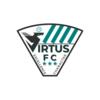
| Name: | Darren Kalthoff |
|---|---|
| City: | Grain Valley |
| Country: | United States of America |
| Membership: | Adult Member |
| Sport: | Football/Soccer |
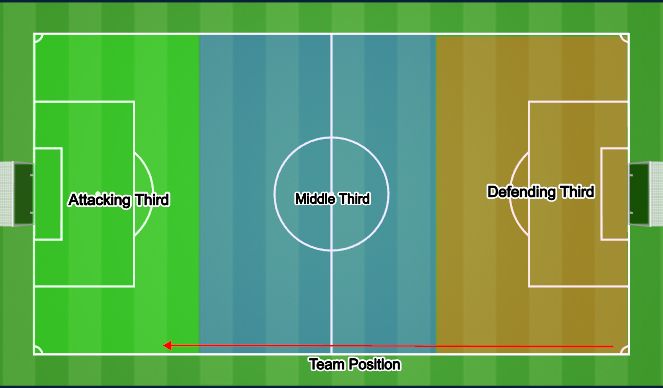
See the guidance at the top of this page to understand why you are not seeing interactive Football/Soccer images.

Horizontal field areas
The Horizontal Field areas are:
- Defensive Third
- This Third is where the team gets the formation tight and flat, and works as a unit in the Middle Channel
- The defense should be playing a zone cover, only marking a player when they are in their zones
- Players should not vacate their zone as it will create a gap in the line
- FORWARDS are expected to get back and be a part of defending in this third and should not stand at the half line and watch
- Patience, discipline, and communication are important in this area
- Players should defend using the three "D"s; Delay, Defend, Deny
- Delay the attack, allowing our team to organize
- Defend against the attack by causing mistakes or tackling the ball
- Deny the opposition by gaining possession
- There should be an urgency in this third to win the ball and transition out as quickly as possible
- The 18-yard box, or penalty box, around the goal, is the DANGER ZONE with urgency to win and clear the ball at an extreme level
- Players are expected to clear a ball out of the zone to the sides
- Middle Third
- Play in this area should be quick, one to two-touch passing playing style
- The build-up to attack is organized in the middle third along with organizing the formation into a defensive role out of possession
- Changing the point of attack in possession
- Delivering diagonal passes for the wings and forwards to run on to in the attacking third
- Attacking Third
- Forwards and Midfielders should play quick, combination ball in this Third
- Creative play in this area is crucial and players should look for 1 vs. 1 opportunities
- Pass, move, and create overloads against the defense to create shots on the goal
- Our teams want to keep the ball in this Third and if possession is lost, we must be aggressive in winning the ball back
- High pressing the defense and taking all passing options away by man-
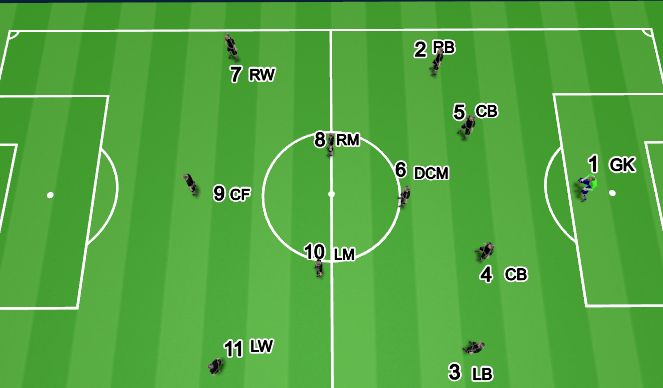
See the guidance at the top of this page to understand why you are not seeing interactive Football/Soccer images.

4-3-3 basics
Organization:
• 4-4-2 defensive shape
• back to 4-3-3 transition from attack to defense
• 3-2-5 on final attack
Roles and Responsibilities:
GK=goal keeper (#1) Distrubution of the ball on goal kicks/saves. Should always look to play to possession. Short pass first option, second option look long. Be the trail option for the defensive backs. Must be able to play at the feet as well as they defend the goal.
CB=Centerback (#5, #4)
Offensively the are the trail pass options for all mids. In my formation one of the center backs will become a defensive mid on transition to attack. They must be patient, disciplined, fierce, and aware of their surroundings at all times. I want them to be able to dribble to space and distrubute the ball effectively.
Always looking to find the attacking mids (#8,#10) or the wide forwards (wings). On a rare instance the stryker (#9) is wide open, I want them to make that pass to break the opponents lines.
Defensively: Stay organized, tight and flat. Direct fullbacks (RB, LB) and midfielders in defensive shape. Collect, clear, or distrubute balls when intercepted.
Fullbacks= RB (#2) LB (#3)
Offensively: Support wide distrubution and trail passes. Look to distrubute to the midfield and wings to support our principles of play. Move into attack when in the attacking third to cross balls into the box.
Defensively: Stay organized, tight,and flat. Protect the outer edge of the formation and block opponent crosses. Win, collect, distribute, and clear dangerous balls played in to our defensive third.
Defensive Center Mid= DCM (#6)
Offensively: This is the pivot player, most of the switching of attack goes through this player. In our transition to a 3-2-5 one of the centerbacks will step up and become a second pivot player. The DCM will distrubute and control the midfield with their passing. They will need to be physical, with good skills, and great vision.
Defensively: First line of defense for the back line and keeper.They need to be disciplined and patient, defending with the three D's of defending, Delay, Defend, Deny. Physicallity and speed are a must at this position.
Attacking Mids= RM (#8), LM (#10)
Offensively: Distrubuting to the wings and stryker, trailing balls to reset the attack, overlap/underlap the forward/wings to make runs and confuse the defense. Able to change speed of play with dribbling, change of direction, and ball movement. Taking shots and sending through balls.
Defensively: Box to box midfielder, they attack and then defend just as quick. Dropping into the center channel next to the DCM and pressuring the wide players into the deep corner to keep our defense in the box. Need to be fast, physical, smart, patient, and disciplined.
FORWARDS/WINGS: CF (#9), LW/RW (#11), (#7)
Offensively: Creativity and aggresiveness in attack. Need to be great finishers and ball handlers. Take shots and create chances.
Defensively: Pressure the ball in the center channel. Delay, Defend, Deny, to allow the defensive shape to take form. High pressure and intensity to slow the opponents attack.
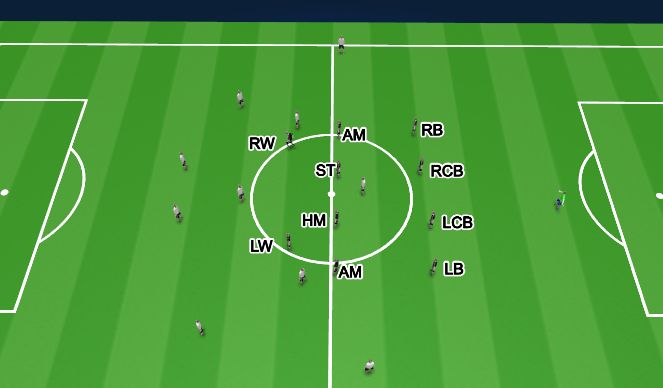
See the guidance at the top of this page to understand why you are not seeing interactive Football/Soccer images.

Out of possession.
Out of possession:
The CF has to get back and drop into the mid field to form a 4-4-2 DEFENSE.
I want 8 people behind the ball at all times, this can only be accomplished if the closest person to the ball pressures the ball carrier and delays their attack. The transition has to be immediately after we lose possession. The CF will drop into the midfield and form a 4 man flat line in front of the back line. Both wings will attack and harass the opponents forwards to win the ball back or slow the counter.
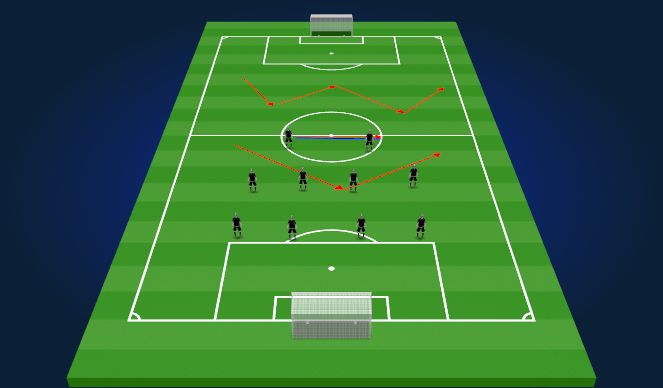
See the guidance at the top of this page to understand why you are not seeing interactive Football/Soccer images.

Animation 5
Offensively: This is where my formation varies a little. We will transition into a 3-2-5. I will explain the movement and why. When we get into the middle third and start our build up to attack the formation will shift into a 3-2-5. These lines are not flat and only looking to move forward.
How we transition: Watch the animation.
As we win the ball and transition out we go to our 4-3-3 attack formation, then as we get in to the middle third a center back steps up and becomes a second DCM. This does two things, it creates two pivot players to play the ball through, and it also allows a better coverage in the midfield to stop a counter attack. The center back that stays is dropped slightly to create depth, the full backs ar wide to creat width, and the attacking mids move up but not flat to the forwards. This will create confusion and marking issues for the other team.
As we move into the attacking and final third the whole formation is high up the pitch and putting pressure on the defense.
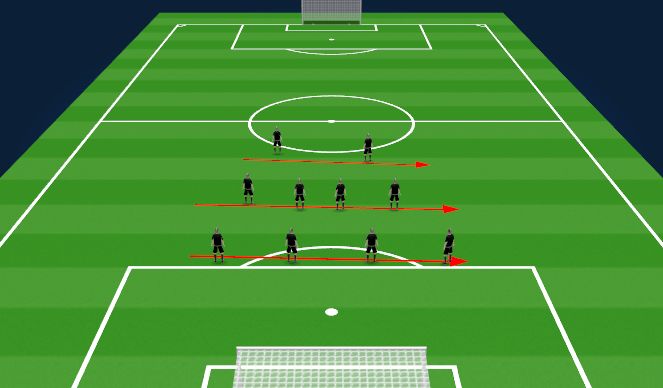
See the guidance at the top of this page to understand why you are not seeing interactive Football/Soccer images.

Defensive shape
Defending:Center forward drops into the midfield and becomes a center mid. The wide forwards/wings pinch into the middle. We have two walls of four, and eight behind the ball. We can only achieve this if one person pressures the ball and forces the other team to slow their counter attack. • We are looking to force wide play out of the middle of the field. We are playing a zone defense. It will take discipline, patience, and communicating with your teammates to know who pressures the ball and when you drop back into your shape after pressuring the ball. • The forwards are applying light pressure to the back line when they trail the ball. Only pressing hard when they are certain that they can win the ball. • We defend as a unit, shifitng left, right, up, and down as the ball moves.• It is the outside back to pressure a pass and player deep into the corner. The formation then shifts to provide support and cut off any passing options and lanes from the deep ball.
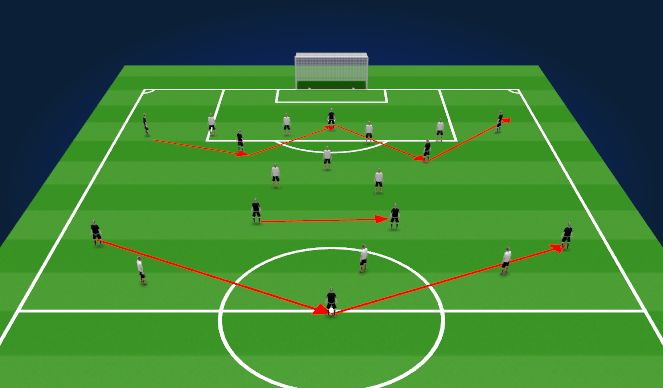
See the guidance at the top of this page to understand why you are not seeing interactive Football/Soccer images.

Attacking Shape
Attacking shape: 3-2-5
We are looking to over load the back line with at least 5 attackers. A centerback steps forward on the attack and becomes a second defensive mid and pivot player. This formation allows for a high amount of possession and trail passing to keep possession and force the defending team to lose their shape.
• The attacking mids occupy the space between and behind the centerforward and wings on both sides of the pitch forming a "W". They are taking shots from the top of the eighteen and feeding through balls to the forwards. They can also make a run if the opportunity presents its self.
• The two pivot players are the trail options to reset the attack. They have the freedom to roam the middle area and be support. They can also make long diaganol crosses into the box.
• The backs are forming a "V" with the centerback being the deepest part of the V. The back line is the deepest trail option if the defending team starts to try and press the trails. The fullbacks can move forward in the attack if it is tactically right in the situation, Meaning the defending team is trying to block the middle and leaving the side channels free.
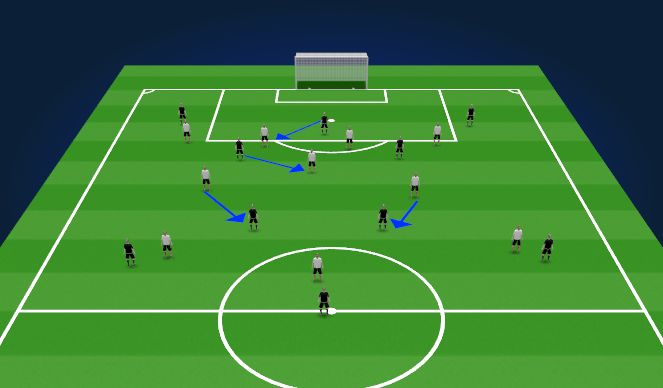
See the guidance at the top of this page to understand why you are not seeing interactive Football/Soccer images.

High Press
High Press: 4-3-3
When we lose possession in our 3-2-5 we will quickly take a high press against the team to win the ball back.
• The CF will step to a CB, as will one of the AM, with the other AM stepping to their DM. The wings will step to their fullbacks.
• The two pivots will step to the attacking mids and the back line will man mark the forwards. We are looking to win the ball back before the defending team can organize and counter attack. We want to keep the ball in their defensive/our attacking third.
• DO NOT press the keeper on the trail. This will create a gap and an open player to start a counter attack with.







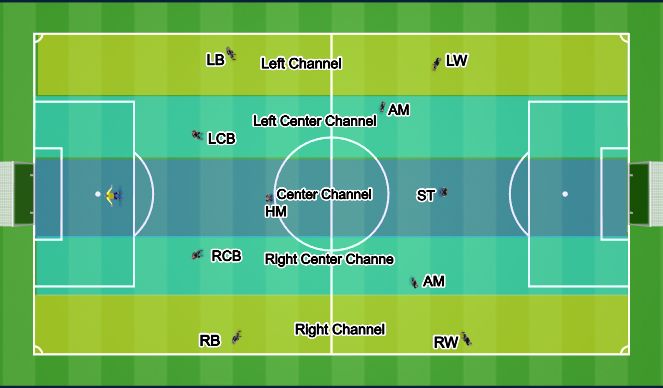
 Play animation
Play animation Play step-by-step
Play step-by-step Repeat (toggle)
Repeat (toggle) Full Screen
Full Screen Pause
Pause Stop
Stop
Verical field areas
At VFC we break the pitch into five horizontal and three vertical pieces. The above illustration is the different vertical channels we use. The left channel, the left center, the center channel, right center channel and the right channel.
• Left Channel is primarily where the left back and left winger (wide forward) will play. We use this area to stretch the opponents formation and use the spaces to implement our principle of play (POP) i-o-i-o or inside-outside-inside-outside. Its focuses on using wide play to open the middle channel to switch the point of attack through.
• Left Center channel The left back and left attacking mid share this vertical space, if the attacking mid is towards the wide area of the channel the back tucks in and vice versa.
• Center Channel is primarily the keeper, the holding mid, and the stryker. This center channel is where we switch the ball to switch the point of attack, and create out attack from.
• Right Center Channel is the right center back and right attacking mid operate here. With the same rules as the LCB and LAM.
• Right Channel Right back and Right winger operate in this space.
2 players in a channel at all times. The players in each channel need to share the space with one another, For example. If the ball is played wide the right back, and they are to the inside of the right channel; then the right wing checks down, and to the wide area of the channel for an outside option, This is the rule for all channels and all players in the channels. THE ILLUSTRATION IS OUR ATTACKING SHAPE! We use the space in this way to draw the other team out to create spaces in, around, and behind the defense of the opponent. We must use the I-O-I-O patterns of play. That is inside-outside-inside-outside patterns of play meaning that if we pass to the LB or RB we are trying to stretch the defense that way, then we play back to the middle, and then we can switch back or switch the point of attack to the opposite side of the field. The most important thing to remember is to keep the ball moving and the opponent off balance.